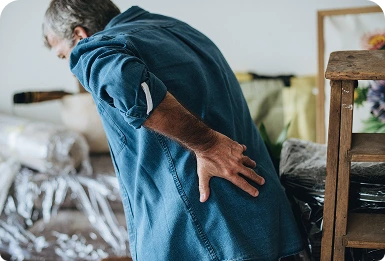Lower back pain affects millions of people worldwide, often striking without warning and disrupting daily activities, such as sitting at a desk and lifting groceries. While the discomfort can range from a dull ache to sharp, debilitating pain, understanding what triggers these episodes is crucial for both prevention and treatment. The causes of lower back pain are surprisingly diverse, spanning from simple muscle strains and poor posture to more complex issues like herniated discs, arthritis, and underlying medical conditions. By identifying the root cause of your back pain, you can take targeted steps toward relief and develop strategies to prevent future flare-ups.

At Advanced Wellness, we understand that effective lower back pain treatment begins with a comprehensive evaluation of your condition. Our experienced healthcare professionals conduct thorough consultations and examinations to identify the root cause of your discomfort. This process typically includes a detailed physical exam to assess your range of motion, strength, and pain levels, along with imaging tests such as X-rays or MRIs when necessary. In some cases, we may recommend a bone scan or other specialized diagnostics to ensure we provide the most accurate diagnosis. When your back pain requires immediate medical attention, our team is equipped to provide prompt, professional care tailored to your specific needs.
Our targeted steroid injection treatments offer powerful anti-inflammatory relief for patients experiencing severe lower back pain. These precise injections are administered directly into the affected area of the spine, allowing us to relieve pain at its source while minimizing systemic side effects. The procedure is performed using advanced imaging guidance to ensure optimal placement and maximum therapeutic benefit.
Our skilled chiropractors utilize gentle spinal manipulation techniques designed to relieve pressure on compressed nerves and restore proper spinal alignment. Through carefully applied adjustments and mobilization techniques, chiropractic care helps reduce inflammation, improve joint mobility, and promote healing of damaged tissues. This non-invasive approach often provides significant pain relief while supporting your body’s natural healing processes.
Working with our physical therapist, patients learn specific exercises and movement patterns designed to strengthen supporting muscles and improve flexibility. Our customized therapy programs focus on proper body mechanics and posture to ensure the body properly supports the spine during daily activities. As pain improves through consistent therapy, patients often experience increased function and reduced risk of future injury.
Advanced Wellness offers a comprehensive range of additional treatment options to address your specific needs. These may include nonsteroidal anti-inflammatory drugs (NSAIDs) to reduce inflammation and pain, as well as specialized approaches tailored to specific symptoms you may be experiencing. Our multidisciplinary approach incorporates orthopedic care when surgical consultation is needed, cutting-edge regenerative medicine techniques to accelerate healing, traditional acupuncture for pain management, and innovative shockwave therapy to stimulate tissue repair and reduce chronic pain.


Dr. Gary L. Yen is Board certified in Physical Medicine and Rehabilitation and has a sub-specialty in Pain Medicine. Dr. Yen grew up in Long Island, NY and received his medical degree from Ross University. He completed his internship in Internal Medicine at Lutheran Medical Center in Brooklyn, NY and performed his residency in Physical Medicine and Rehabilitation at Stony Brook University, where he was chief resident.
Dr. Yen completed a pain management fellowship at RehabNY in Buffalo, NY, during which he served as the assistant athletic trainer to the Buffalo Bison, the Minor League AAA baseball team for the Cleveland Indians, as well as the Niagara University men’s and women’s collegiate hockey team.
The former chairman of the Physical Medicine & Rehabilitation Division of the Pain Management Department at CentraState Medical Center, Dr. Yen specializes in the non-operative treatment of a variety of joint, muscular, nerve, skeletal, spine and sports related injuries. He treats acute and chronic pain syndromes and performs electrodiagnostic studies. Dr. Yen also performs variety of interventional pain procedures and minimally invasive spine surgery for the relief of pain. He utilizes conservative treatments such as physical therapy, chiropractic care and acupuncture in conjunction with other procedures to enhance long term benefits. Dr. Yen believes in working with patients to create individual treatment plans.
When not attending to his patients, Dr. Yen likes to play golf, cook, and has a passion for playing the saxophone and piano. He is the proud father of two boys.